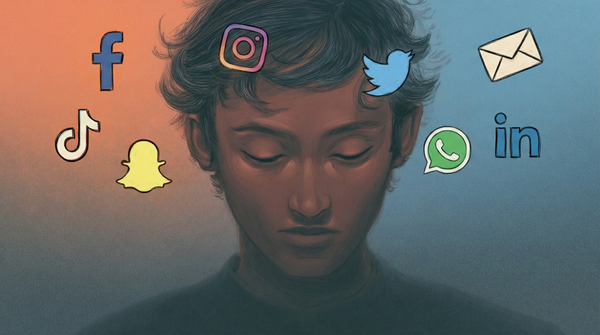Dark Psychology in Politics: Why Leaders Sign Harmful Laws-Machiavellian Calculus, Moral Distance, and the Slippery Slope of Incremental Harm
Why do leaders advance policies that hurt people? We unpack the dark psychology of power-Machiavellianism, moral distancing, incremental harm, just-world beliefs, and group polarization-using real case studies and research.

Here's the weird thing about power: People in charge often sign their names to laws that they know - absolutely know - will make people's lives harder.
Not in a "we didn't see that coming" way. Not in a "tragic accident of policy" way. In a fully-briefed, impact-assessed, every-warning-issued way. And they still do it.
If you've ever looked at the news and thought, "How is that even legal?" "How can they sleep at night?", you're not crazy for asking. The answers are messy, and they say a lot about how humans think, not just politicians.
This isn't a story about corruption or moustache-twirling villains. It's about psychology. About the strange, predictable ways our minds can justify harm when it's dressed up as necessity, or hidden behind statistics, or aimed at people we've decided "deserve it."
In this piece, we're going to map five of those mental shortcuts:
- Machiavellianism - when holding onto power matters more than protecting people.
- Moral distancing - how harm feels smaller when you frame it as numbers instead of names.
- Incremental harm - the slow drip of small changes that add up to big cruelty.
- Just-world fallacy - the comforting but dangerous belief that people get what they deserve.
- Group polarization - how echo chambers can make extreme ideas sound like common sense.
Why should you care? Because these aren't just political tricks. They show up in workplaces, in friend groups, in online spaces - anywhere humans make decisions that affect other humans.
Learn to see them, and you'll start spotting the moment harm gets reframed as "necessary." You'll notice when debate rooms go quiet. You'll feel when empathy gets smoothed out of the story. And once you see it, it's harder for someone to use it on you.
So let's answer the question: How do politicians seem to make decisions they know will hurt people-and convince the rest of us to accept it?
The Blueprint of Harm: From Face to Figure

Cruelty in politics rarely arrives snarling. It walks in carrying a spreadsheet.
The numbers look tidy. The charts are clean. The harm is abstract: neatly packaged into "trade-offs" and "efficiency savings." What used to be a breathing person is now a decimal point. That's the first trick: turn a face into a figure.
Psychologists know this move well. It's called the identifiable victim effect: we're wired to feel more for one vivid life than for a thousand anonymous ones. A mother with a name, a child with a photo - that's when wallets open, laws bend, and movements ignite. But once those lives are rendered as "1,000 affected," something in us shuts down.
Psychologist Paul Slovic calls it psychic numbing. The more people suffer, the less each life matters to us emotionally. It's a paradox: suffering scales up, urgency scales down. Leaders don't have to deny the damage-they just have to talk about it from far enough away. From 30,000 feet, even disaster looks like data.
This numbing is measurable. Experiments show compassion drops by the second endangered life. By the third, the numbers may as well be abstract art. And that's dangerous-because it's emotion, not statistics, that moves us from that's sad to we need to act.
So the language shifts. Harms become "marginal effects" or "a small percentage." Benefits get a name and a face. It's not an outright lie. It's framing. And it works.
This isn't just a political maneuver. You'll see it in a boardroom when layoffs are discussed as "10% headcount reduction." In a family when pain is brushed off as "not that bad." In a group chat when real harm is dismissed as "drama."
How to stop it
If you can catch the moment when someone shifts from face to figure, you can pull the conversation back to where ethics actually lives. Start with the question politicians avoid: Who, exactly, will this hurt-and what's their name?
Machiavellian Moments: Power Before People

Not every harmful law is born from hatred. Some are born from calculation.
Machiavellianism isn't about cackling villains-it's about survival. It's the instinct to treat morality as optional when it gets in the way of power. In psychology, it's one corner of the "Dark Triad," alongside narcissism and psychopathy. The Machiavellian type doesn't need to believe a policy is good. They just need it to be useful.
Niccolò Machiavelli advised rulers to do what was necessary to hold power, even if it meant cruelty. Today, the playbook is more subtle: dress the cruelty in rational-sounding terms, bury it under "long-term fiscal stability," and make sure it rallies your base.
Recent research shows that leaders scoring higher on Machiavellian traits can polarize their followers more deeply - sharpening "us vs. them" divides. And the more polarized the public, the more a leader can get away with. Harm to the out-group isn't just tolerated-it's rewarded.
You've seen it before: a bill that cuts aid to the most vulnerable, sold as "tough but necessary." A regulation rolled back, not because it's broken, but because dismantling it plays well to a loyal bloc. The real moral question isn't "Is this right?" - it's "Will this keep us in power?"
In politics, cruelty doesn't need to be personal. It just needs to be strategic. And when the calculus is survival, suffering becomes a line item you can justify.
Moral Distancing in Policy: Numbers That Numb

You can't feel what you can't see. And in politics, that's often the point.
Moral distancing is the quiet art of keeping human consequences at arm's length. It's when the impact of a policy is reduced to statistics, ratios, or "projected outcomes" that no one can picture. You stop thinking about people. You start thinking about performance indicators.
Paul Slovic's research on psychic numbing shows how compassion drops as numbers rise. One child in danger triggers urgency. A thousand children in danger turns into a bar graph-and urgency evaporates.
Politicians lean on this without saying so. Harsh welfare cuts become "streamlining." Hospital closures are "consolidation." Civilian casualties are "collateral damage." Euphemisms create distance. Distance dulls empathy.
It's not that the suffering isn't real - it's that it's buried in language designed to be unfeeling. You don't picture a pensioner skipping meals; you picture a budget "efficiency" target being met. You don't imagine a child without an inhaler; you imagine "cost-containment."
And here's the danger: moral distance isn't just for ministers and presidents. We do it at work when we talk about "downsizing" instead of layoffs. We do it in friend groups when someone's pain becomes "overreacting." The moment harm turns abstract, accountability goes with it.
How to stop it
The fix starts with making it personal again-dragging the consequences back into the room, even when the room would rather talk numbers. Ask the question the spreadsheet can't answer: What's the story behind this statistic?
Incremental Harm: How "Just One Change" Becomes a Regime

Big cruelty rarely arrives in one piece. It comes in instalments.
Psychologists call it the foot-in-the-door effect: agree to a small request, and you're more likely to agree to a bigger one later. In politics, the first step might be a "minor" eligibility tweak, a "temporary" funding freeze. The next step cuts deeper. By the time the damage is obvious, it's been normalised.
Ethicists talk about ethical fading-when repeated exposure dulls the moral weight of a decision. The more often harm happens in small doses, the easier it is to stop seeing it as harm at all. Ten cuts over ten years feel less outrageous than one catastrophic slash, even if the outcome is the same.
Policy analysts have another term: policy drift. That's when laws stay on the books but aren't updated, allowing their impact to worsen quietly as circumstances change. It's neglect masquerading as stability.
Incremental harm works because each step seems survivable on its own. The outrage that might have erupted over one massive blow gets spread thin over years. By the end, the system has shifted so far that the starting point feels like a different country.
The danger isn't just in the big bill that makes headlines - it's in the quiet clauses that don't.
"They Deserve It": The Just-World Story We Tell Ourselves

The easiest way to live with someone else's suffering? Convince yourself they earned it.
Psychologist Melvin Lerner called it the just-world hypothesis-the deep-seated belief that people get what they deserve and deserve what they get. It's a comforting lens if you're safe and thriving. It's a brutal one if you're on the wrong side of policy.
In politics, just-world thinking makes harmful laws palatable. Cuts to unemployment benefits? "They should've worked harder." School lunch programs slashed? "Parents should be more responsible." Healthcare rolled back? "They should've made better choices." Once you've framed hardship as a moral failing, cruelty looks like justice.
This isn't just theory-it's visible in speeches, debates, and press releases. Leaders deploy personal responsibility narratives to turn public sympathy away from those harmed by their policies. The more the public buys the "deserve" story, the easier it is to legislate harm without backlash.
And here's why you need to spot it outside the voting booth: just-world bias shows up everywhere. A friend loses their job, and the first thought is what they "did wrong." A colleague is harassed, and you wonder what they "could have done differently." It's self-protection-if their suffering is their fault, then yours is avoidable.
But that comfort comes at a cost. It blinds you to systemic causes, excuses the powerful, and isolates the vulnerable. Once you see the just-world reflex for what it is, you can start dismantling it-in politics, in workplaces, in families-before it turns empathy into indifference.
Group Polarization: Echo Chambers with a Vote

Put a group of like-minded people in a room, and they'll walk out more extreme than when they went in.
Cass Sunstein calls it group polarization: the tendency for discussion among the like-minded to push everyone further toward the edges. In politics, it's a force multiplier for harmful laws. Inside a party caucus, a closed-door committee, or a partisan media bubble, dissent becomes dangerous. Agreement becomes a loyalty test.
The more insulated the group, the less reality seeps in. Nuance dies first, then empathy. Leaders surrounded only by allies hear their harshest proposals echoed back as "bold," "principled," or "long overdue." Harm stops feeling risky; it starts feeling righteous.
This is how policies that would seem unthinkable in public can pass with near-unanimous support behind closed doors. In the echo chamber, they aren't cruel-they're consensus.
Why it matters to you: group polarization isn't just a Capitol Hill problem. It shows up in Slack channels, neighborhood associations, online fandoms, even family dinners. When everyone shares the same view, the room tilts, fast. Without friction, compassion can drain away, replaced by a kind of collective certainty that justifies anything.
How to stop group polarisation
The antidote is simple but uncomfortable: keep a dissenting voice in the room. Seek it out if it's not there. Because when a group gets too good at agreeing with itself, harm stops looking like harm-and starts looking like policy.
Case Files: When Policy Hurt-What the Record Shows

It's easy to think of these forces-moral distance, Machiavellian calculus, just-world bias-as abstract ideas. Until you see the paper trail.
Below are examples of politics using these ideas, to often devastating effect:
US Family Separation (2018)
Under the "Zero Tolerance" policy, thousands of children were taken from their parents at the border. The American Academy of Pediatrics warned the separations would cause irreparable harm to children's mental and physical health. The HHS Inspector General later found the government had no clear system to track or reunite families. Public justification leaned hard on "deterrence" and "rule of law"-classic moral distancing.
UK Universal Credit Roll Out
Billed as "streamlining welfare," the shift to a single benefit system left claimants facing payment delays and increased debt. A 2020 Lancet Public Health study found the policy was associated with higher psychological distress among claimants, and a 2024 Journal of Epidemiology & Community Health paper linked it to poorer child mental health. Euphemistic framing-"simplification," "work incentives"-kept the human cost at arm's length.
The Bedroom Tax (UK, 2013)
Officially called the "spare room subsidy removal," this housing benefit cut disproportionately hit low-income disabled people. Researchers found increased poverty, mental health strain, and in some cases, relocation from support networks. The moral cover? "Fairness to taxpayers."
Austerity & Health Inequalities
Post-2010 funding cuts to UK local authorities were associated with stalled life expectancy improvements and widening health gaps, particularly in deprived areas. The framing: "living within our means." The result: measurable harm.
Post-1996 US Welfare Reform (TANF)
Heralded as a "success" for reducing caseloads, the shift left millions of eligible families without assistance. Analyses show deep poverty rates rising, especially for single mothers. The just-world narrative - "ending dependency" - helped sell it.
These aren't edge cases. They're proof of what happens when psychological levers meet legislative power. And they matter because the same moves-distance, incremental harm, moral framing-can slide into local councils, company boards, even school policy decisions.
If you can trace the harm back to the mechanism, you can name it before it happens again.
Breaking the Spell: How to See Harm Coming

The forces we've traced-moral distance, Machiavellian calculus, just-world bias, polarisation aren't rare defects in certain leaders. They're human defaults sharpened by power. That's what makes them dangerous.
You can't stop every harmful bill. But you can learn to see it before the signatures dry. The tells are always there:
- Harm framed as numbers.
- Consequences described in euphemisms.
- Cuts sold as "fairness" or "necessity."
- Debate rooms where no one dissents.
And here's the uncomfortable part: these aren't just political tells. They're personal ones. In workplaces, it's a restructuring memo that hides job losses in percentages. In friend groups, it's gossip reframed as "just telling the truth." In families, it's harm excused because "they should've known better."
The same psychology that lets a parliament pass a harmful law is the psychology that lets a group of friends turn on someone. The scale changes. The mechanism doesn't.
Breaking the spell starts with making harm visible. Name the person behind the number. Challenge the frame. Invite dissent. And refuse the comfort of the just-world lie.
Because policies don't just drift toward cruelty on their own-they drift because no one notices the small steps. If you can catch those steps-in a policy, in a meeting, in your own thinking-you can stop them from turning into something unrecognizable.
Power counts on the fact that most of us won't.
Want to learn the techniques of manipulation for yourself? Join the Dark Mirror Collective.
Join now for 50% off.






